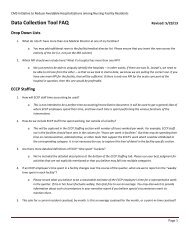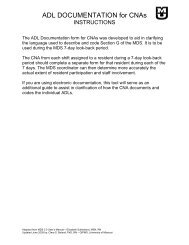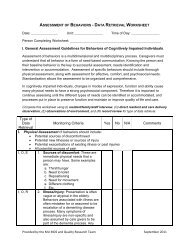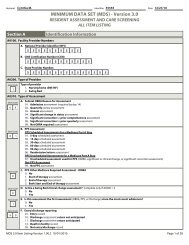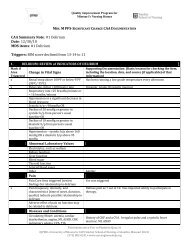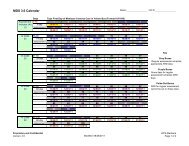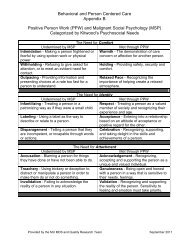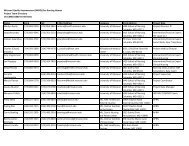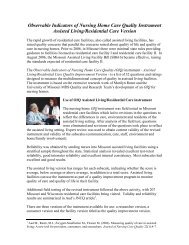National Guideline Clearinghouse (NGC). Guideline synthesis
National Guideline Clearinghouse (NGC). Guideline synthesis
National Guideline Clearinghouse (NGC). Guideline synthesis
You also want an ePaper? Increase the reach of your titles
YUMPU automatically turns print PDFs into web optimized ePapers that Google loves.
Areas of Agreement<br />
Assessment of Pressure Ulcer Risk<br />
Both guidelines agree on the need for timely assessment of pressure ulcer risk<br />
and most explicitly recommend a combination of informal (i.e., clinical judgment)<br />
and formal (i.e., use of a risk assessment tool) methods. As a formal risk<br />
assessment method, use of a standardized tool is recommended by both<br />
guidelines. The Braden Scale and the Norton Scale are mentioned as appropriate<br />
instruments by both groups. Both guidelines also agree on the need for<br />
reassessment when a patient's clinical condition changes, or on a regular basis for<br />
high-risk patients.<br />
Skin Care and Protection<br />
Both guidelines address skin care as a prevention intervention and recommend<br />
daily assessment of skin. There is overall agreement that keeping the skin dry and<br />
moisturized is an important prevention step. Both guidelines stress the need to<br />
avoid vigorous massage, especially over bony prominences. They also address the<br />
need to protect the skin from friction and shear, particularly during transfer and<br />
repositioning, as well as the need to manage moisture from incontinence. RNAO<br />
specifically recommends establishing a bowel and bladder program for incontinent<br />
patients.<br />
Positioning and Pressure-Relieving Devices<br />
Recommendations concerning positioning and pressure-relieving devices are<br />
similar between guidelines, with both noting the need for frequent repositioning of<br />
bed-bound and chair-bound patients and the need to use pressure-reducing<br />
mattresses and positioning devices such as wedges and pillows. Both groups<br />
recommend use of a written repositioning schedule and caution against the use of<br />
doughnut-type devices. RNAO specifically cites the need for use of a pressurerelieving<br />
mattress during surgery for at-risk patients.<br />
Nutrition<br />
Both groups stress the importance of adequate nutrition as a part of pressure<br />
ulcer prevention. HIGN cites the need for adequate hydration, protein, calories,<br />
and vitamins A, C, and E. Both guidelines recommend consultation with a dietitian<br />
to assess nutritional needs and develop a nutritional support plan.<br />
Patient, Carer, and Professional Education<br />
The need for education aimed at patients, carers, and professional staff is<br />
recommended by both groups. The groups are in agreement that educational<br />
programs should be structured, organized, comprehensive, and directed at all<br />
levels of healthcare providers, patients, and families or caregivers. RNAO stresses<br />
the importance of incorporating updated information and new technologies into<br />
educational programs.<br />
Other Interventions<br />
16 of 17



